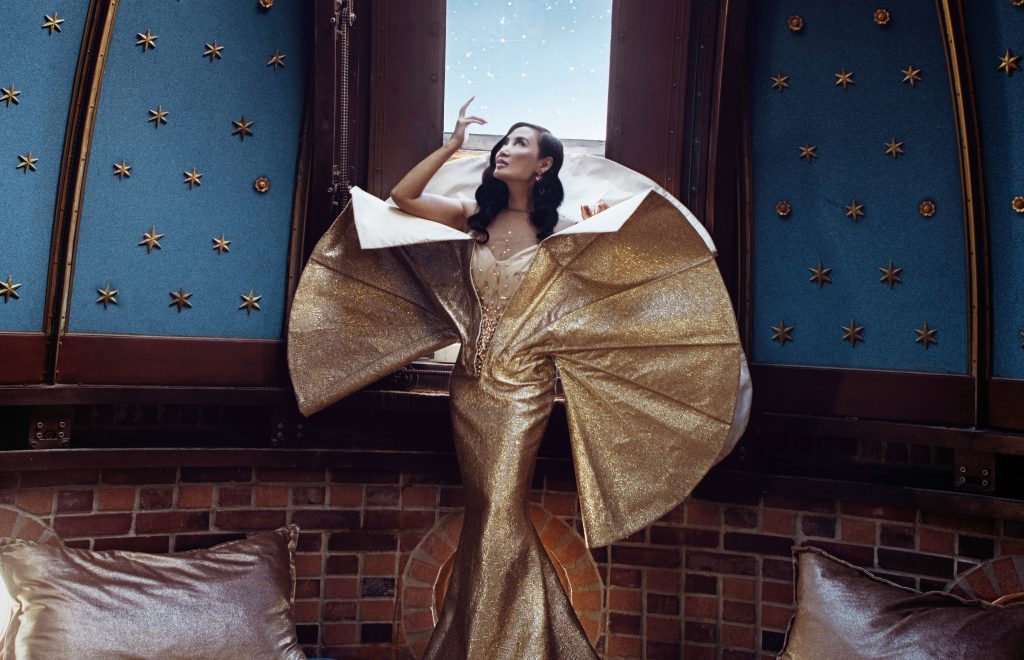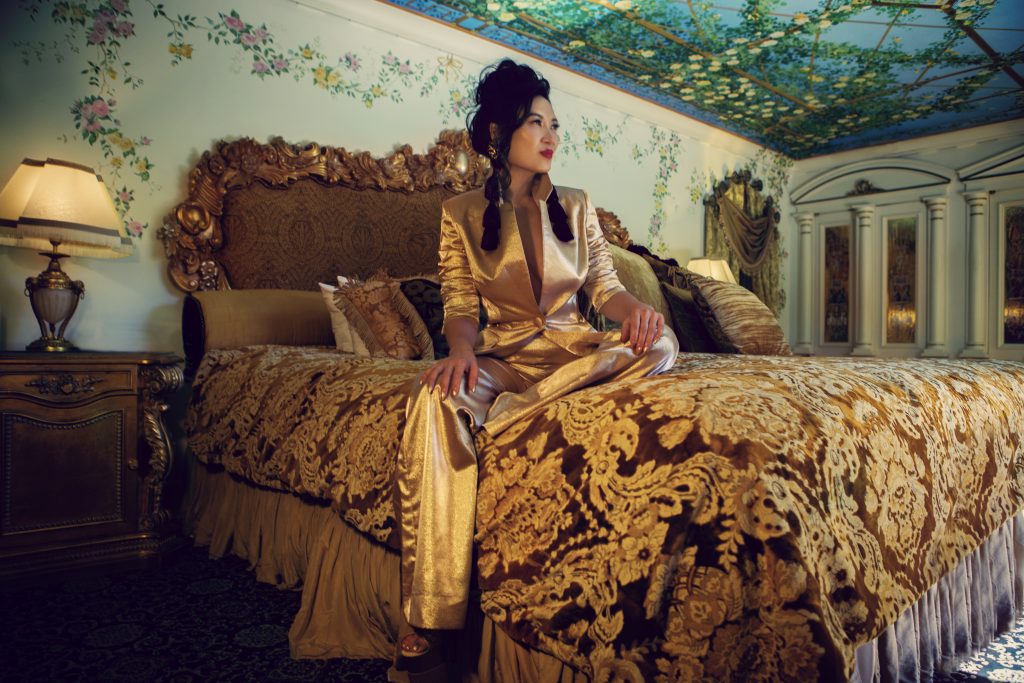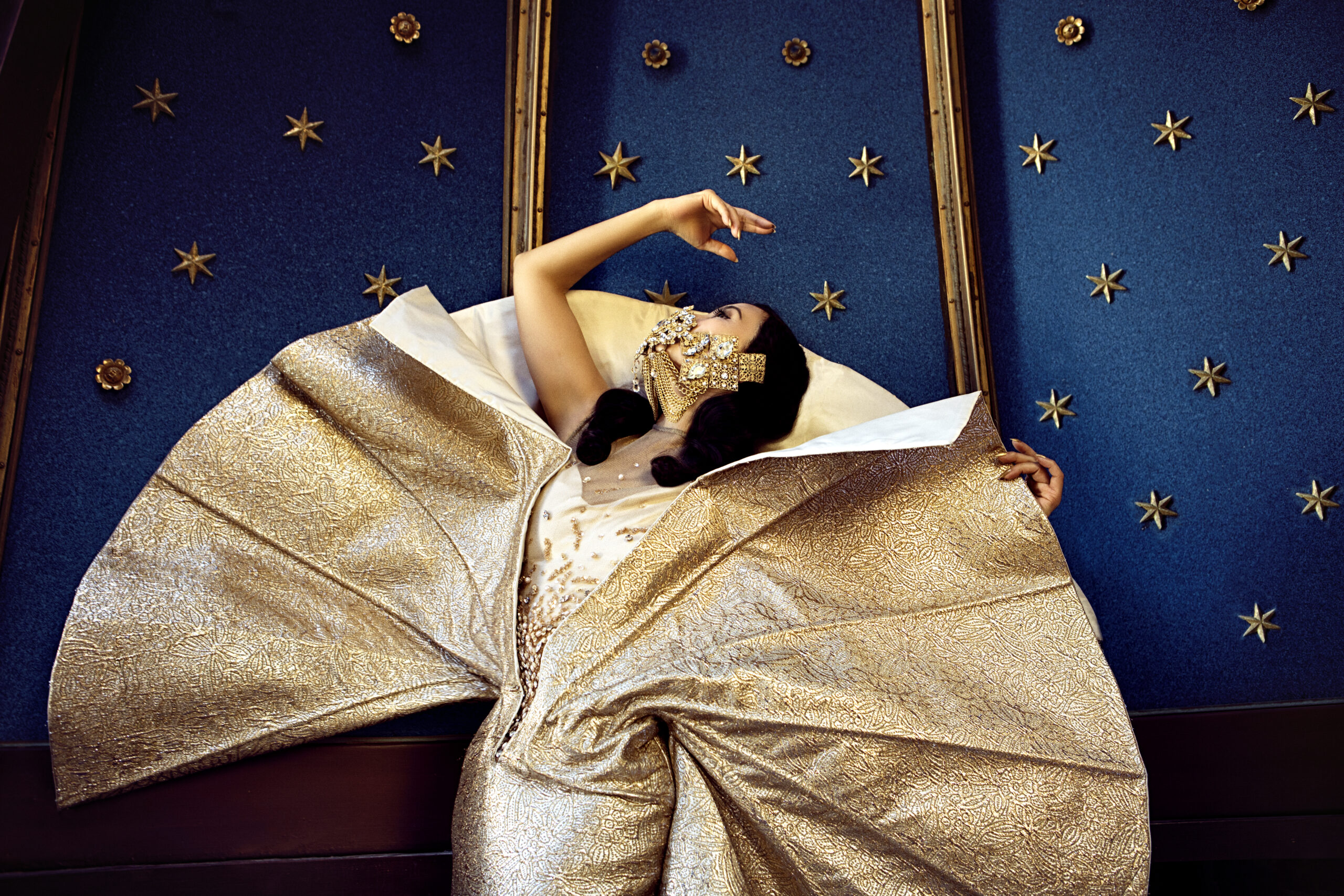An Interview with Claudia Nakash
Words by Lisa Wayne
Photographer Viktorija Pashuta
Stylist Jesse J
Stylist Assistant Anna Everett
MUA Donna Mee
MUA Assistant Bridget Ortega
Hair Jill Turnbulls
Photo Assistant Hamid Kootval
Video Paul Ayala
Location The Villa Casa Casuarina
While attending the British Colonial School in Hong Kong, Claudia Nakash had an epiphany. Realizing her destination was not that of the charmed socialite, she set out on a path to change the art world. A bold venture, but with her parent’s encouragement, she traveled the world to learn and absorb as much knowledge as possible, discovering the desires and preferences of different cultures and how they each uniquely related to art.

Bodysuit Victoria’s Secret, Cape wings Cecilia Aragon
Living in the Middle East, Europe and the United States, Nakash has made a name for herself amongst the elite, the up-and-coming, the art critics and historians alike. She now offers her business card with a delicate bow and humbly asks to be of service, a gesture that perhaps Westerners are unfamiliar, but one of genuine interest and kindness. Petite and pretty, her heart-shaped face in elegant repose, Nakash is an influencer in the grand style of the global art dealer. Just back from Art Basel and our divine shoot at the Versace Mansion, Nakash is excited to talk about her all-consuming passion: art.
Women loved Gianni Versace. They said his clothing made them feel ultra-feminine and ultra-chic. What is your connection to this extraordinary man?
Members of my family acquired the Versace Mansion in 2013 with the thought of preserving the beautiful architectural heritage of the legendary fashion designer. It was his sanctuary for many years and his personal style is felt throughout the home and the grounds. It is the magical place of one who lived and breathed art every day of his life.
Would you share with our BASIC readers some of the recent works of art you helped facilitate between collectors?
It would be my pleasure to discuss them, but I cannot reveal the names of the people I work with or even the paintings themselves. All is very hush-hush in the art world when it comes to who owns what. There are very important and valuable pieces of extraordinary art that move about and find new homes in new collections, and the majority of the owners of these large, private collections prefer to remain completely invisible. I will mention, though, that some of the artists that I have had the pleasure to be intimately involved with are Picasso, Kusama, Dali, Basquiat, Gerhard Richter, Warhol, George Condo, and Van Gogh, to name a few.

Dress Jean Louis, Jewelry Marianna Harutunian
Do people often ask you what is “good” art or “bad” art? Is there such a thing?
It is hard to say. Good art is the art that touches your heart. Maybe you like color or maybe you like black and white, but it is where you fall in love, and that is good art.
If you had to make one, what would be your prediction for 2018 on the next big trend in contemporary art?
My current prediction is that paintings under $15,000 by emerging artists are a good place to invest. They are less risky in this political and economic climate. I like Kaws One very much and some other new primitive artists as well. Paintings over a million are in a wait-and-see pattern right now.
“Most of my other colleagues prefer to remain anonymous, but become known to my clients as we go through the process, which is sometimes nerve wracking but always very, very exciting.”
You’re working with a laboratory in Luxembourg. Can you tell us a little more about that project?
I am working with a small group of experts. We are all dedicated to the preservation and authentication of historical pieces. This lab will make available hyperspectral fingerprinting among other methods for collectors to be able to verify the origin and even the DNA of their works. This will help eliminate a lot of the risk associated with buying and investing in, say, the Old Masters, as documentation is so limited in many cases.

Dress Jean Louis, Earrings Dsquared2
Owning historical paintings is a privilege not given to many. Along with it comes great responsibility to care for them and keep them safe. How do you help your clients handle this?
I strive to make my clients comfortable with the whole process. I have surrounded myself with some of the best key business advisors in this industry. One of them is lawyer Don Burris, who is involved in many of my transactions. He actually recently recovered an iconic Gustave Klimt painting stolen by the Nazis from Maria Altman’s family. I also count on advice from my friend Xavier Jover, formerly the department head of two major auction houses, who guides me in certain purchases. Most of my other colleagues prefer to remain anonymous, but become known to my clients as we go through the process, which is sometimes nerve-wracking but always very, very exciting. We learn as we go, as each piece comes with its own set of challenges and rewards.
“I would like to make art more popular in my homeland like music is, or films or sports. I would like to have it be more integrated into the broad culture, not just exclusive for only a few to enjoy.”
You have an incredible story about Michelangelo’s graffiti. Can you share a little bit about this?
Yes, that is a funny story, but it is true. I was honored recently by a dear friend with an invitation to visit a secret cave beneath the Sistine Chapel only discovered in 1975. It was here that Michelangelo hid for four months during a coup d’état against the Medici family in 1530. It is a very small, hidden chamber and he covered the walls with his sketches! These were all done in charcoal and would later prove to be studies for his David. Even in hiding and in fear for his life, his work evokes such a depth of feeling. This space is not on view for the public, as your very breath can alter the delicate climate that preserves the 56 drawings.

Dress Jean Louis, Earrings Dsquared2, Shoes The Trend Haus
In closing, would you share with us some of your dreams for the future?
I would like to make art more popular in my homeland like music is, or films or sports. I would like to have it be more integrated into the broad culture, not just exclusive for only a few to enjoy. I see having more public art in outdoor areas, murals, shopping malls, cafes and green spaces. Also, supporting art education in schools. When you understand a subject, you are more likely to embrace it, protect it, and put it there for future generations.
Order a Print Copy of Issue 7 Here.
You may also like
-
NEW ERA NEW RIMON
-
VIN LEE – Luxury’s Billionaire on Wheels
-
FROM VISION TO REALITY: Yan Cameron Javeri on Leading the Visionaries
-
SHINING THROUGH DARKNESS – Brandy Ledford’s Journey to Sobriety and Self-Love
-
GASHI – The Birth of the Brooklyn Cowboy
-
EVIL GENIUS: MIKE COLTER on Family, Film, and the Virtue of Humanity
